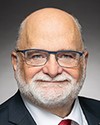Good afternoon, Mr. Chair and honourable members of the Standing Committee on Health.
It is my great honour to provide a statement before this committee on such an important topic during such a challenging time.
It is my hope that during the course of this discussion I may be able to provide some insights as to how Taiwan has approached its fight against COVID-19 and that we will have the opportunity to discuss how countries such as Canada and Taiwan can share their experiences to better combat this virus. Allow me to take a moment to reflect upon Taiwan's experience.
Despite its proximity, close trade ties and tourist exchanges with China, Taiwan avoided the worst consequences of the pandemic. Indeed, with only 446 confirmed cases, seven deaths and 72 straight days without local transmission, Taiwan's success has allowed schools and businesses to remain largely open and operational as normal.
As Taiwan is neither a member nor an observer of the World Health Organization, this was all accomplished without the timely access to critical information that many other countries have benefited from. How then was Taiwan able to successfully fight the disease?
First, our fight began before the enemy was even present. Following the hard lessons of the 2003 SARS outbreak, Taiwan comprehensively reformed how it prepared for and would respond to eventual outbreaks.
Another key to our success was our government's quick and decisive action at the very beginning. When our Centers for Disease Control learned of atypical pneumonia cases in Wuhan, we began actively screening passengers as they arrived in Taiwan. This action started on December 31, 2019, more than three weeks before Wuhan entered its lockdown period.
At the same time, Taiwan warned the WHO about a potential novel virus in Wuhan with human-to-human transmission. Regrettably, this warning was ignored, and the global community lost valuable time in terms of preparing for and combatting the virus. It must be stressed that Taiwan's exclusion from the WHO remains an impediment to global health, so we are grateful for parliamentarians in Canada and throughout the world who have supported Taiwan's meaningful inclusion in this organization and other international fora.
As the situation in Wuhan worsened, the Government of Taiwan activated its central epidemic command centre, or CECC. The CECC established a clear chain of command and began holding press briefings that disseminated accurate, up-to-date and transparent information to the public a full three days before Wuhan entered its lockdown.
Moreover, the CECC was led by medical experts who jointly held important political offices. Minister of Health and Welfare, Dr. Chen Shih-Chung served as the chief for our CECC, holding daily press briefings and coordinating all public efforts at the national level.
Our approach to combatting the disease and informing the public was proactive and aggressive. This had the dual effect of stemming the virus early and combatting disinformation by gaining the public's trust.
Over the course of the pandemic, the CECC has initiated more than 120 COVID-19 countermeasures. These include various restrictions on movement and travel, health screening at points of entry, mandatory self-isolation and much more.
The CECC also coordinated communication in an orderly and clear fashion so as to provide the most accurate real-time information. Moreover, we applied innovative, data-driven information technology solutions to track the spread of the virus, combat community transmission and allow citizens to have up-to-date information on the availability of crucial supplies to avoid panic buying. This was only possible through the consolidation of real-time data from a variety of government ministries and through the active co-operation of Taiwanese citizens.
Importantly, Taiwan made every effort to secure its supply chains for crucial medical goods, such as masks. We implemented a system whereby each citizen was provided with a stable allotment of masks, while production was simultaneously ramped up so that we could maintain a steady supply of personal protective equipment, PPE, for our citizens and health care workers.
Taiwan's strategy has allowed for a daily production of up to 20 million masks. This has meant that our government has been able to provide masks and other crucial medical supplies to countries around the world, including Canada. To date, we have contributed 1.5 million surgical masks, 100,000 N95 masks and 100,000 protective and isolation gowns to Canada in total, through the Canadian Red Cross, for distribution to front-line health care workers and indigenous communities.
We believe it is imperative that countries with the means to help one another do so openly, graciously and co-operatively. Taiwan is striving to do precisely that.
As for what can be done to further this co-operation, it is useful to consider the joint partnerships that our government has engaged in with other countries. For instance, Taiwan is conducting joint research and development of rapid tests, vaccines, treatments, information technology and more with our partners in the United States. We also maintain agreements with a variety of countries to ensure stable access to important medical supplies.
In any case, Taiwan stands ready to co-operate openly and in good faith with the Government of Canada. In that spirit, it our hope that countries like Canada can work with Taiwan to develop and share solutions. By working in concert with one another, I am sure that our two countries can promote better health outcomes for our societies and the world at large.
Honourable Chair and members of the committee, on behalf of Taiwan, I would like to express my sincere gratitude for your time and thoughtful consideration. I look forward to taking your questions later.




